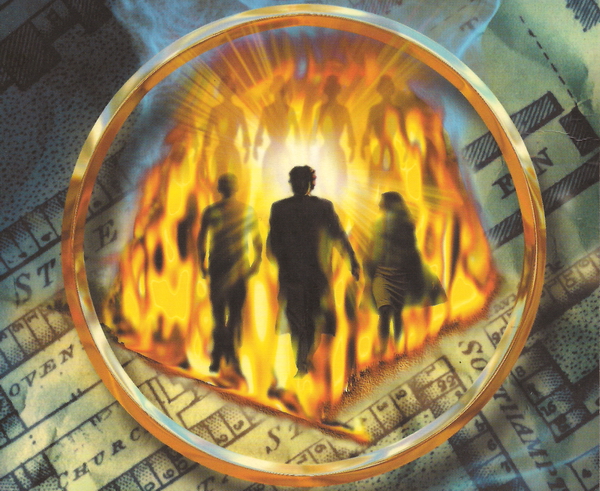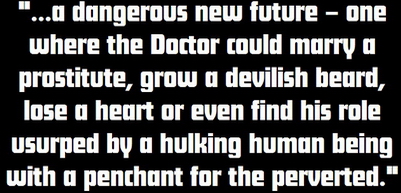|
| |
|
STORY PLACEMENT THIS STORY TAKES PLACE BETWEEN THE
NOVELS "GRIMM
WRITTEN BY LAWRENCE MILES
RECOMMENDED PURCHASE OFFICIAL BBC 'EIGHTH DOCTOR' PAPERBACK (ISBN 0-563-53842-2) RELEASED IN NOVEMBER 2001.
BLURB On February 9, 1783, a funeral was held in the tunnels at the dead heart of London. It was the funeral of a warrior and a conjuror, a paladin and an oracle, the last of an ancient breed who'd stood between THE Earth and the bloodiest
of
its nightmares. sorceress, this is THE history OF SCARLETTE: the part she played in the Siege of Henrietta Street, and the sacr- ifice she made in the
defence
of her
world. up to that funeral, something raw and primal ate its way through OUR society, from the streets of pre-Revolutionary Paris to the slave- states of America. Something that only the eighteenth century could have summoned, and against which the only defence was a bordello in Covent
Garden.
'elemental champion' who stood alongside SCARLETTE in the final battle. The one they called the Doctor. |
|
|
The Adventuress of Henrietta Street NOVEMBER 2001
This is true:
When they decided to excise Gallifrey from the universe, they didn’t do so simply to inject the Doctor with a little bit of audience-building angst or even to set him up as a lonely old rover. They did it to be rid of it, and rid of it in every sense. When the Doctor pulled that lever at the end of The Ancestor Cell, he removed his home world from the face of creation, taking all its possible pasts and futures with it and leaving him a walking, talking paradox; an impossible thing in a universe’s that’s never had the Time Lords watching over it, yet is still reeling from their traumatic removal.
The Adventuress of Henrietta Street marked the start of a new chapter for the Doctor and for his universe. After a succession of brilliant but tentative tales, once again the Doctor’s adventures found themselves vested with a sense of purpose and excitement. Rather than obsessing over the canonically-expunged history of the Doctor, this book set my head alight with musings on a dangerous new future – one where the Doctor could marry a prostitute, grow a devilish beard, lose a heart or even find his role usurped by a hulking human being with a penchant for the perverted.
Rather fittingly, it would fall to Lawrence Miles, the author who first pulled at the thread that unravelled the Whoniverse’s abstruse tapestry, to forge a new future, and true to form he would do so in the most provocative and damned ingenious fashion. The Adventuress of Henrietta Street is not a novel but a history book; a collection of fragmented accounts and conflicting testimonies bound together by rampant hearsay and speculation. Any sense of narrative convention is cheerfully thrown out of the window as Miles’ blood-soaked chronicle details not so much a story but a collection of increasingly-powerful metaphysical images. Exploiting his readers’ separation from events, Miles breaks new ground for the series as he uses brutal accounts of rape and torture to reflect the inner demons of his protagonists. Teasing the readership with omniscient conceit, he litters his text with spoilers of what is to come, taking quantum leaps forward only to wind straight back. Toying with the terror of the purists, he starts to re-write the rulebook.
The events of this novel are set over an entire year, taking us from March 1782 right up to February 1783 and the Siege of Henrietta Street. The babewyns, a race of time-jumping apes from the edge of human knowledge, are running amok on Earth, and the Doctor has come to stop them. Making a home for himself in a bordello populated by occultist demi-reps, the bearded Doctor realises that, as one of the last “elementals” in the universe, to save the world he must root himself to it by marrying a perplexing young virgin, Juliette. However, before he’s able to do so, the creeping malaise that’s been ailing him for more than a century brings him right to the edge of death, and before you know it he’s having a blackened heart removed and marrying a hooker in a church besieged by apes whilst his new arch-rival shakes his bloated fists at the sky. It’s unequivocally Doctor Who, yet at the same time fresh and… unbound.
Like all the most memorable post-Ancestor Cell novels, this is a book with the Doctor at its core. With the same zeal that he employed when he laid waste to the series’ foundations, here Miles does the same to its eponymous hero, taking him probably closer to death than he’s ever been before in all his lives, and even robbing him of his role in the universe before building him back up again stronger. We are made privy to The Ruminations of a Foreign Traveller in His Element, the Doctor’s autobiographical work, which is positively abounding with the scent of lost memories and traditions; each passage rife with subversive subtext. We see the Doctor’s mortal body break, and hear his spirit snap. And then, with the flick of baddie’s blade, Miles removes the last apparent vestige of Gallifrey from the Doctor’s body, finally allowing him to recover from his impossible wound and go onto become the Earth’s champion.
Just as stimulating though is the full debut of Sabbath – a new type of antagonist for a new type of universe. A middle-aged, shaven-headed bull of a man, Sabbath is not merely a new recurring adversary for the Doctor, but a proxy for him too. In the absence of the Time Lords, one human being is to appoint himself the protector of Time, but unlike the Doctor he is not constrained by decency or morality. Indeed, the inside of his ship, The Jonah, reads like an x-rated version of Jabba the Hutt’s palace, with Sabbath’s naked concubine chained up by his throne. He’s no Master either though, as subtly illustrated by the death of Tula Lui and his emotional reaction to it. Like everything else in this new Whoniverse, Sabbath is a stirring shade of battleship grey.
himself seems to be on hand to pass the torch to his successor of sorts. In one of the novel’s most talked-about scenes, the bearded Doctor finds himself face to face with a clean-shaven man wearing a Rosette, who he appears to recognise as his old foe. Once again Miles underlines the lack of certainty in the world as the apparently affable Master reflects on his role as the Doctor’s opposite number and wherever that may lead him, speculating that one day it might fall to him to save the universe from the Doctor, as opposed to the other way round. This is not simply a nod to the Doctor’s potential Valeyard incarnation, but a reminder of what this Doctor has done and what he is capable of doing in his future. This little skit also allows the author to squeeze in a cutting metafictional critique of the classic television series and all its foibles, as well as whet his readers’ appetites for future adventures with talk of the four surviving “elementals”, whoever they may be…
It’s the sign of a great novel when one’s principal grievance concerns the infinitesimal size of its print. Give the man another hundred pages for heaven’s sake; paper’s not that expensive. One could also take umbrage with Miles’ non-handling of companions Fitz and Anji, who are both afforded such diminutive roles here that he might as well have left them out, but then I’m sure that he would have done, given the choice. I suppose we should at least be grateful that Anji didn’t end up with “I am human filth” tattooed on her forehead, which she might well have done had the author been given free reign.
In the end, The Adventuress of Henrietta Street proved to be
Lawrence Miles’ fourth and final endowment to a range of novels that his
ideas helped shape more than anyone else’s. Though his Doctor Who
works may be sparse, their influence is always keenly felt, and none of
them more so than this volume. The Doctor may not lay his own body to rest
or unwittingly unravel his own past here, but he’s subjected to one of the
most brutal deconstructions of all his lives, only to emerge from its
flames re-affirmed and re-invigorated. And with unfinished histories,
too numerous to recount here.
|
|
|
Copyright © E.G. Wolverson 2010
E.G. Wolverson has asserted his right under the Copyright, Designs and Patents Act, 1988 to be identified as the author of this work. |
|
|
This novel sees the Doctor’s second heart, which has become diseased in the absence of Gallifrey, surgically removed by Sabbath. Don’t fret though – it’ll grow back.
The Master’s escape from the TARDIS’ Eye of Harmony is detailed in the comic strip The Glorious Dead. How he survived the events of The Ancestor Cell is admittedly bit of a poser, though.
|
|
|
Unless otherwise stated, all images on this site are copyrighted to the BBC and are used solely for promotional purposes. ‘Doctor Who’ is copyright © by the BBC. No copyright infringement is intended. |
|

.jpg)
.jpg)

 And
quite beautifully, the Master
And
quite beautifully, the Master